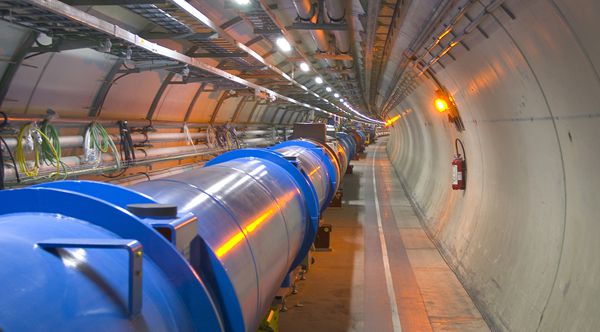-
 Plantibodies
Plantibodies
-
 Transalaska
Transalaska
-
 Eccentric anomaly
Eccentric anomaly
-
 Virophage
Virophage
-
 Gas laser
Gas laser
-
 Azoospermia
Azoospermia
-
 Antioxidants
Antioxidants
-
 Pyroclastic flow
Pyroclastic flow
-
 Crohn's disease
Crohn's disease
-
 Gibberellins
Gibberellins
-
 Affiliation
Affiliation
-
 Cuesta
Cuesta
-
 THX
THX
-
 Ring Nebula
Ring Nebula
-
 Bit rate
Bit rate
-
 Phases of the Moon
Phases of the Moon
-
 MAN
MAN
-
 M 105
M 105
-
 Crustacean
Crustacean
-
 Panspermia
Panspermia
-
 Pioneer species
Pioneer species
-
 Main sequence star
Main sequence star
-
 Vanograph
Vanograph
-
 Generalised epilepsy
Generalised epilepsy
-
 LOX
LOX
-
 Molecular hybridisation
Molecular hybridisation
-
 Hercules globular cluster
Hercules globular cluster
-
 Ecological continuum
Ecological continuum
-
 Tertials
Tertials
-
 Pallas
Pallas
LHC
With a circumference of 27 kilometres, the LHC (Large Hadron Collider ) is the largest and most powerful particle accelerator in the world.. The LGC is on the Franco-Swiss frontier and is the responsibility of CERN. The first beams of particles, protons, travelled round it on 10 September 2008 and the first collisions were produced on 30 March 2010.
A video from the site Du Big Bang au Vivant with a commentary on the LHC by Jean-Pierre Luminet. © Groupe ECP, www.dubigbangauvivant.com/Youtube
Beams of protons (going at 99.999999 % of the speed of light) and even heavy ions circulate in it when it is working. The aims of the LHC in standard physics are to detect the Higgs boson and to study quagma, a plasma of quarks and gluons produced by the collision of heavy ions. The detection of the Higgs particle is required to completely validate the standard model for the electroweak interaction in QCD. The quagma is a hadrionic state of matter that should be found in some neutron stars and during the first moments of the universe. It will be studied with the Alice detector.
As for non-standard physics, the possibilities are vertiginous!
The mission of the LHC
First of all: the detection of supersymmetric particles in the standard model should be the subject of most of the attention; this is the task of the Atlas and CMS (Compact Muon Solenoid) detectors. Finding the Higgs particle should give us an important key to understanding the mass of the particles in the universe and perhaps the nature of dark matter. LHCb (the LHC beauty experiment) should also tell us something about supersymmetry, but its main objective is to understand CP violation, vital to solving the matter/antimatter asymmetry problem.
Secondly, revealing extra spatial dimensions, and even detecting the creation of mini-black holes, with Atlas and CMS, are among the most exciting possibilities. String theory could even be confirmed!
Barring surprises, it will probably not be until the end of 2012 that the LHC will have collected a large enough quantity of data to test these theories, which are still highly speculative.
A few figures about the LHC
- The Large Hadron Collider is a ring-shaped collider 27 kilometres long situated in a tunnel at about 100 metres underground, near Geneva;
- The total energy in the centre of mass will be 14 TeV (7 times higher than the Fermilab Tevatron) which will enable the search for new massive particles up to ~ 5 TeV;
- Luminosity = 1034 cm-2 s-1 (over 100 times higher than for the Fermilab Tevatron). This will make it possible to search for rare processes;
- The frequency of revolution is 11.2 kHz (11 200 times per second).
- Energy consumption: ~ 120 MW ;
- Each full intensity proton beam will be made up of 2 808 bunches of particles;
- Eachbunch will contain 1.15 x 1011 protons;
- The bunches are several centimetres long but they are only 16 micrometres across just before collision;
- The total length of the superconducting cables required is around 7 600 kilometres. Each cable is made of filaments, the total length of which is 10 times the distance from the Earth to the Sun;
- The vacuum in which the proton beams circulate is very hard, at only 10-10 torr (~ 3 million molecules/cm3); this is to avoid collisions with gas molecules as much as possible. It is equivalent to the pressure at an altitude of 1000 kilometres. Atmospheric pressure is 760 torr;
- The LHC superconducting magnets are cooled to 1.9 Kelvins with superfluid helium at atmospheric pressure.
- The LHC will store an energy beam of around 360 megajoules: 2 808 bunches x 1.15 1011 protons each with an energy of 7 TeV = 2808 x 1.15 x 1011 x 1012 x 7 x 1.602 x 10-19 joules = 362 MJ per beam. This can be compared to:
- In kinetic energy:
- 1 small 10 000 tonnes cruiser moving at 30 km/h ;
- 450 2 tonnes vehicles of moving at 100 km/h.
- In chemical energy :
- The explosion of 80 kilograms of TNT ;
- The metabolising of 70 kilograms of chocolate (counting the calories); the energy in the chocolate is released rather more slowly than in an explosion of TNT!
- In thermal energy:
- That required to melt 500 kilograms of copper;
- That required to bring 1 cubic metre of water to 85°C or to prepare 1 tonne of tea.
- In kinetic energy:
To learn more
 The LHC in its 27 kilometre circumference tunnel. © LHC
The LHC in its 27 kilometre circumference tunnel. © LHC
Latest
Fill out my online form.



